Okay, so I’ve encountered some wild edible mushrooms at random in years past. More as an accidental discovery than as a grand pooh-bah of the world of fungus. So I decided that when the conditions were right, that I’d take a trip to the woods with the sole purpose of seeing how many mushrooms I could find, and hopefully identify.

The less mature Black Trumpets seem to be more of a milk chocolate color, and mature to a dark chocolate color.
Holy donkey, there are a lot of mushrooms out there! On prior mushroom encounters, I saw mushrooms that were bright or in some way obvious, and mostly during the fall months because I was out hunting or scouting already. Aside from this being a trip devoted entirely to finding edible mushrooms, this was also the first time I even tried to find mushrooms during the summer months. I know that I’m going to sound like an unbelievable pocket protector wearing nerd here, but it was freaking fun! It’s like an adult Easter egg hunt!
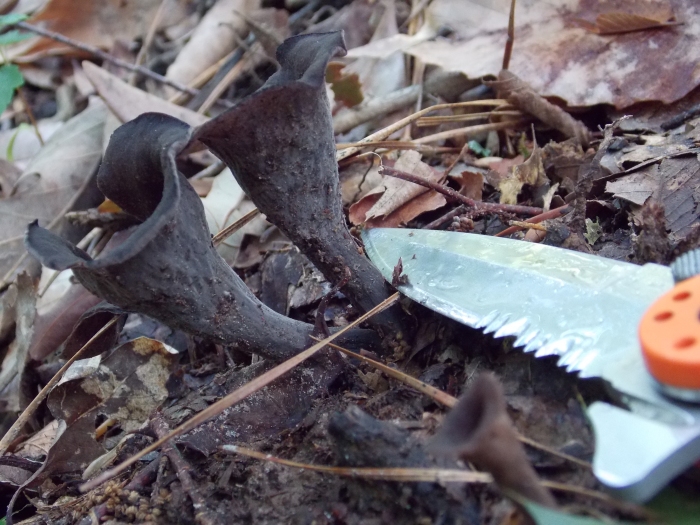
You two are coming home with daddy!!
I found a multitude of mushrooms that I recognized, and many that I have no earthly idea what they were, but I took pictures so I can try to identify them later. When I thought of mushrooming, it all seemed so mystical, and other worldly. Or it seemed like a bunch of four-eyed college professors with disheveled hair dressed like they still live in their grandmother’s basement wondering around, wide eyed at things that nobody cares about, except maybe another pasty-white chicken legged dork. It isn’t that way at all. It was a very nice way to spend an evening, and I got some scouting in for bow season while I was at it. And a little exercise never hurt anybody.
One of the mushrooms I found is considered by many to be the most delicious wild mushroom of them all. It also has a reputation for being one of the most difficult to find because of it’s camouflage.
THE BLACK TRUMPET…
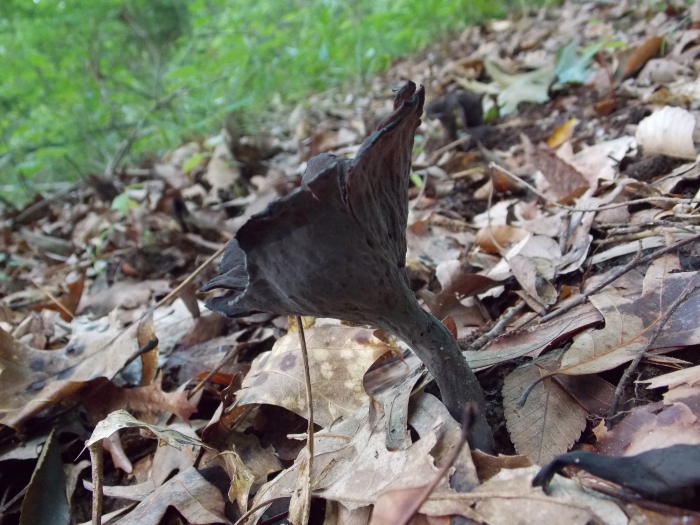
The Black Trumpet in all its glory!
Also known as the Horn of Plenty, and sometimes as a Black Chanterelle. I like to use scientific names for wild edible plants in order to eliminate any confusion between the common names. However, I’m quickly learning that with mushrooms the scientific names are prone to change. The Black Trumpet is sometimes known as Craterellus cornucopioides, and in some literature as Craterellus fallax & sometimes both!
These guys are freaking ugly. They look like something that the devil would play jazz with. The french call these Trompette de la Mort (Death’s Trumpet or Trumpet of Death), and I totally get that. Despite its morbid appearance, I was so excited to find this mushroom because they are so difficult to spot in the leaf litter, and because they are a choice edible mushroom. Some say that the Black Trumpet is the best tasting wild mushroom there is beating out a list of well known gourmet choices including the infamous morel, chanterelle, and even the porcini (king bolete).
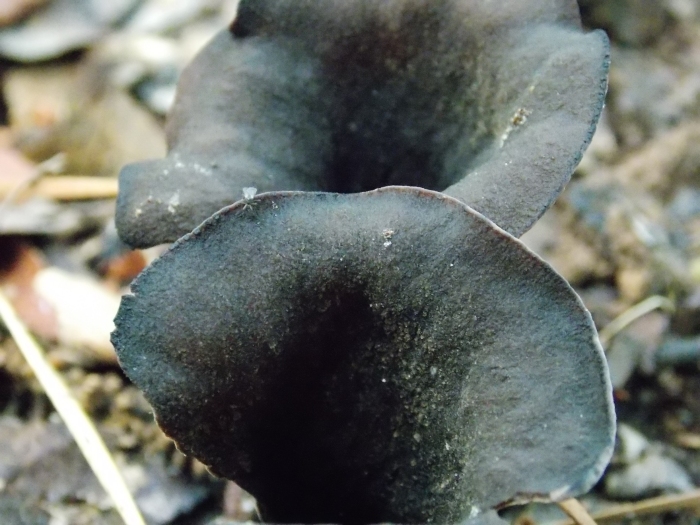
See the unmistakable funnel or horn shape. Shoo-Fly!
The best part about finding this mushroom is that there is really no dangerous look-alike unless you’re really stretching things. Every other look-alike is another edible member of the same family of mushrooms (Craterellus).
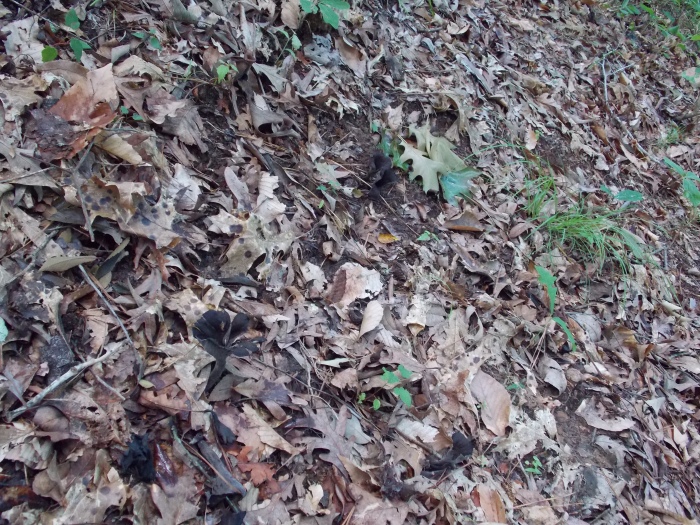
You can see from this photo why they are harder to find than some brightly colored mushrooms (and I’d already moved a lot of the leaves away before this picture)
For looking like something that one of Harry Potter’s Dementors would poop out, they smell fantastic. I dried mine to preserve it for later, and while drying they emit a wonderful fruity aroma that’s difficult to explain. I can’t wait to put these in a dish.
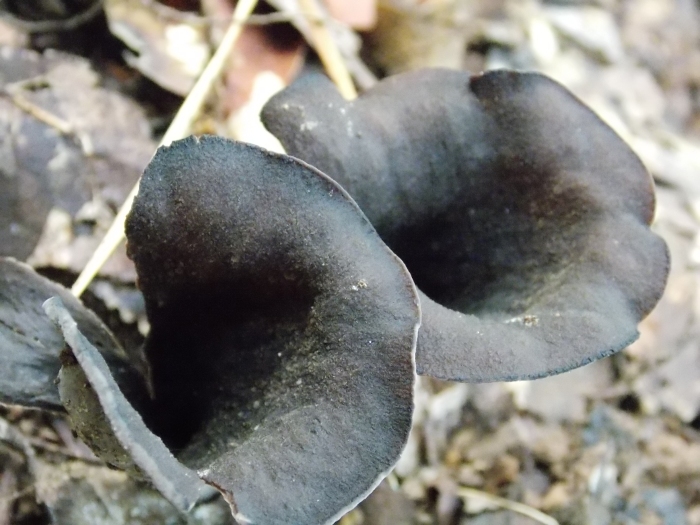
Appearance:
- The cap and stalk are trumpet shaped, or funnel shaped.
- They are black, dark brown, or charcoal gray in color.
- They grow as a single mushroom (not in a cluster or clump from the same base), although they can sprout out in a flush close together.
- They are smooth in appearance on the inside of the “trumpet” as well as the underside.
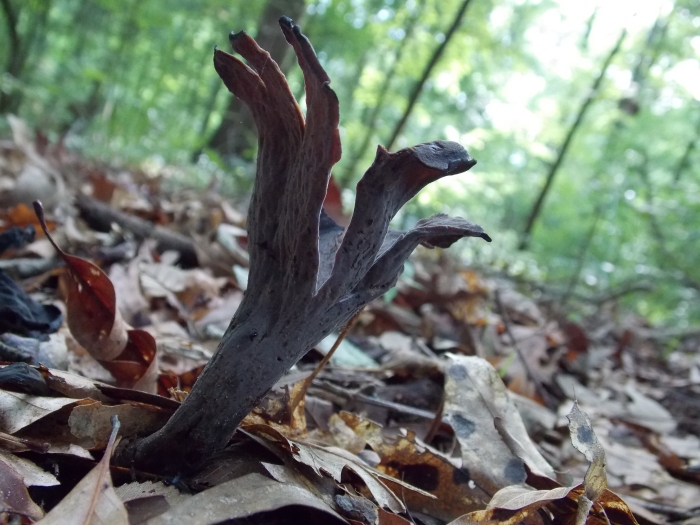
Fragrance:
- Strong aroma with a mushroom-y fruity smell. The smell is unique and stronger than chanterelles, but with a similar fruity aroma.
- As they dry, the pungency increases, which is great because these store well when dried.
Where to Look:
- They seem to like deciduous forests (trees that loose their leave in the fall).
- They prefer beach, oak, etc.
- The Black Trumpets pictured in this article were found near a creek, underneath an old red & white oak stand with mature beach trees mixed in.
- They are known to grow throughout North America (this one was found in Louisiana on the North side of I-20).
- This one was found in fertile sandy soil.
When to Look:
- Depending on your location & conditions they will pop up from May through November.
- These were found in the first two weeks of May in Louisiana.
- Looking after a rain doesn’t hurt. I found these after a few days of rain, and it rained on me during the collection of these ugly little gems.
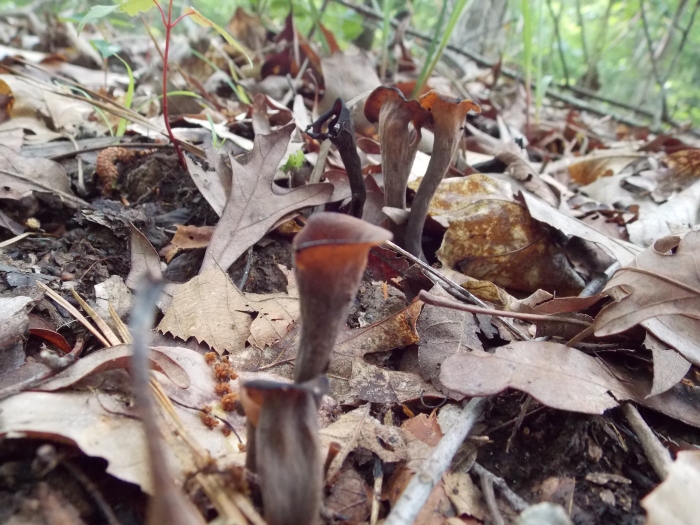
See how some appear brown and some black (the same color as the rich soil and leaf litter)
Once your eye picks up on one, stop right there before you unintentionally step on the ones you don’t see yet. You will begin seeing them all over the place like your mind suddenly picked an invisible lock.
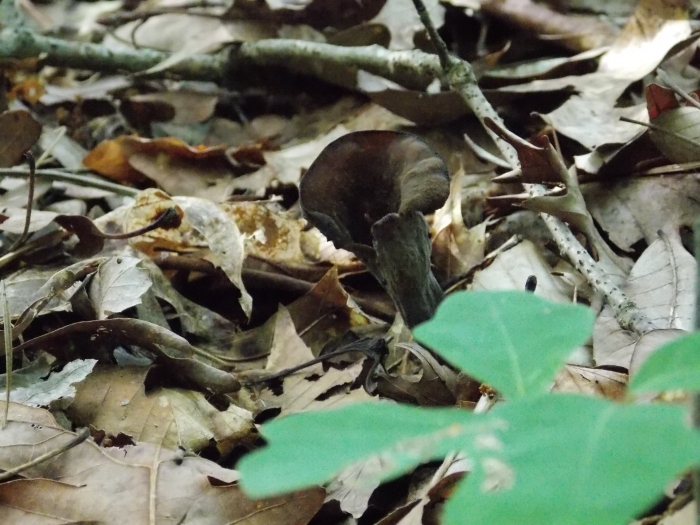
A mushroom only a fatty could love!
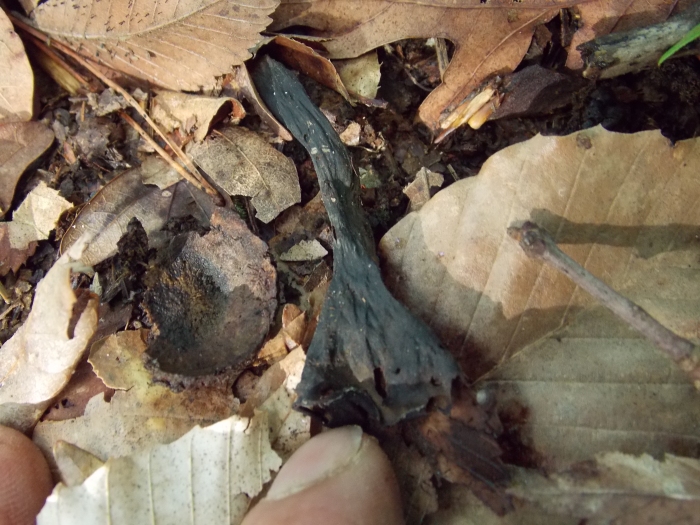
This Black Trumpet is past its prime, and should not be eaten.
Oh, and a little word to the wise. The old wilted, and usually darker Black Trumpets that are not edible put off a crazy fruity smell that is very pleasing. However, they should not be eaten because they can’t be digested, and can cause stomach upset.
Here’s where I tell you to not be a moron, and don’t eat things that you can’t identify. Don’t run with the scissors, don’t make that face or it will get stuck like that, and wait an hour after eating to go cliff diving. Use multiple reputable guides and an expert before you have a positive identification. If one small thing seems out of place, or doesn’t match the plant or mushroom you are trying to identify, then it probably isn’t what you think. Don’t try to force an ID. Always assume that the plant or mushroom you are trying to identify is poisonous until you have proven otherwise, never the other way around.
Sounds delicious! I’ll take a look, and see if I can find some down here in Oz!
LikeLiked by 1 person
I hope you do. Most of the literature I’ve looked at states that its range is “Throughout North America,” so Oz may not have the Black Trumpet. Good luck, and let me know if you find any.
LikeLiked by 1 person
I hope to find these as well this season. I went out foraging yesterday and found that I was still at least 1-2 weeks away from Morel season. Very disappointed. The wait is harsh. But I didn’t come home empty handed. I came home with Soloman Seal spears, Stinging Nettle and a Spring Black bear. Just need those mushrooms now 😉
LikeLike
Wow, that’s a heck of a haul. If I came home with a black bear, I’d be buried under the jail, because they are a threatened species here. Canada black bear is def. on my bucket list. What are Soloman Seal Spears?
I’m sure whatever Morels we would have around here (I’ve never found one), would be gone by now. I look forward to reading about your Morel adventure.
LikeLike
Black bear is a threatened species there eh? Here, because of the last few warm winters and great berry years, there are a ton of cubs surviving. Huge population growth here and we are already allowed 2 per year. Lots and lots of 2-3 year olds around. Too many. I think we will have a problem year with black bears around here. 😛
I’ll be doing a write up on Solomon Seal Spears/shoots soon. But for now, you could probably google it, both: Solomon Seal and False Solomon Seal. Both are edible varieties.
LikeLike
Wish I could help with the bear problem, lol. And I look forward to your write up.
LikeLike